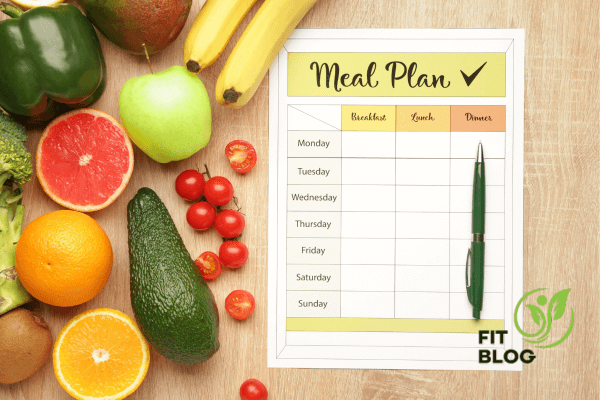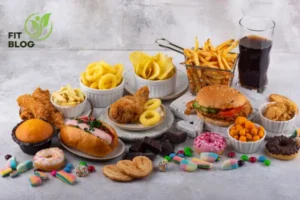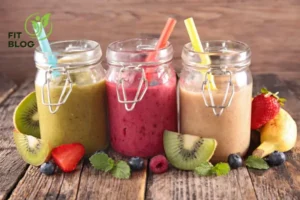Weekly meal plan for weight loss can simplify your journey, helping you make healthier choices and stick to your goals. A well-structured meal plan ensures you get balanced nutrition, control portions, and resist the temptation of unhealthy foods. In this guide, we’ll walk you through the steps to create an effective meal plan that supports your weight loss journey.
Understanding Your Goals with a Weekly Meal Plan
Define Your Weight Loss Goals
Before diving into meal planning, it’s crucial to understand your weight loss goals. Are you looking to lose a specific number of pounds, or are you aiming to improve overall health and fitness? Setting clear, achievable goals helps keep you motivated and focused.
Calculate Your Daily Caloric Needs
Weight loss fundamentally comes down to consuming fewer calories than you burn. To get started, calculate your Basal Metabolic Rate (BMR) using an online calculator or the following formula:
For women: BMR = 655 + (4.35 × weight in pounds) + (4.7 × height in inches) – (4.7 × age in years)
For men: BMR = 66 + (6.23 × weight in pounds) + (12.7 × height in inches) – (6.8 × age in years)
Next, multiply your BMR by your activity level to get your Total Daily Energy Expenditure (TDEE). Subtract 500-1000 calories from this number to set your daily caloric intake for weight loss.
Importance of Balancing Macronutrients
Balancing macronutrients – proteins, carbohydrates, and fats – is key to a healthy diet. Aim for a ratio that suits your lifestyle and preferences, such as 40% carbs, 30% protein, and 30% fat. This balance helps maintain energy levels, muscle mass, and overall health while losing weight.
If you are interested in a vegan diet this is the best option
Planning Your Meals with a Weekly Meal Plan
Importance of Meal Diversity
Eating a variety of foods ensures you get all necessary nutrients and prevents meal fatigue. Plan meals that include different proteins, grains, vegetables, and fruits.
Tips for Including a Variety of Food Groups
1. Proteins: Include lean meats, fish, eggs, dairy, beans, and legumes.
2. Carbohydrates: Choose whole grains like brown rice, quinoa, oats, and whole-wheat products.
3. Fats: Incorporate healthy fats from avocados, nuts, seeds, and olive oil.
4. Fruits and Vegetables: Aim for a colorful plate with a variety of seasonal produce.
Incorporating Whole Foods, Lean Proteins, and Healthy Fats
Whole foods are minimally processed, providing more nutrients and fiber. Lean proteins help build and repair muscles, while healthy fats support brain function and satiety. Combining these elements in your meals can enhance weight loss efforts.
Creating a Shopping List
Importance of Planning Ahead
Planning your meals and creating a shopping list can save time and money, reduce food waste, and ensure you have all the ingredients needed for healthy meals.
Tips for Shopping for Fresh, Seasonal, and Local Produce
1. Shop Seasonal: Seasonal produce is often fresher, tastier, and cheaper.
2. Buy Local: Local markets often offer fresher options and support the community.
3. Organic When Possible: Choose organic for produce that is heavily sprayed with pesticides.
Avoiding Impulse Buys and Sticking to Your List
Stick to your shopping list to avoid impulse buys, which are often unhealthy snacks and processed foods. Shop the perimeter of the store where fresh foods are usually located.
Meal Prep Tips
Benefits of Meal Prep for Consistency and Time Management
Meal prepping ensures you have ready-to-eat meals, reducing the temptation to order takeout. It saves time during the week and helps maintain consistency with your diet.
How to Batch Cook and Store Meals Properly
1. Batch Cooking: Cook large quantities of staple foods like grains, proteins, and vegetables.
2. Storage: Use airtight containers to store meals in the fridge or freezer.
3. Labeling: Label containers with the date and contents to keep track of freshness.
Essential Tools and Containers for Meal Prepping
Invest in good-quality containers, a set of measuring cups, a food scale, and a slow cooker or instant pot to simplify meal prepping.
Sample Weekly Meal Plan
Detailed Example of a Weekly Meal Plan
Here’s a sample plan to get you started:
Monday
– Breakfast: Greek yogurt with berries and honey
– Lunch: Quinoa salad with chickpeas, cucumber, tomatoes, and feta
– Dinner: Baked salmon with roasted sweet potatoes and steamed broccoli
– Snacks: Apple slices with almond butter, carrot sticks with hummus
Tuesday
– Breakfast: Oatmeal with banana and flax seeds
– Lunch: Turkey and avocado wrap with mixed greens
– Dinner: Grilled chicken with quinoa and green beans
– Snacks: Cottage cheese with pineapple, mixed nuts
Wednesday
– Breakfast: Smoothie with spinach, protein powder, and frozen berries
– Lunch: Lentil soup with whole-grain bread
– Dinner: Stir-fried tofu with brown rice and mixed vegetables
– Snacks: Hard-boiled eggs, celery sticks with peanut butter
Thursday
– Breakfast: Whole-grain toast with avocado and a poached egg
– Lunch: Tuna salad with mixed greens and vinaigrette
– Dinner: Beef stir-fry with broccoli and cauliflower rice
– Snacks: Greek yogurt with granola, fresh fruit
Friday
– Breakfast: Scrambled eggs with spinach and mushrooms
– Lunch: Chicken Caesar salad
– Dinner: Spaghetti squash with marinara and turkey meatballs
– Snacks: Edamame, protein bar
Saturday
– Breakfast: Smoothie bowl with mixed fruits and chia seeds
– Lunch: Veggie burger with a side salad
– Dinner: Shrimp tacos with cabbage slaw and avocado
– Snacks Dark chocolate, rice cakes with hummus
Sunday
– Breakfast: Pancakes with fresh berries and maple syrup (portion-controlled)
– Lunch: Grilled veggie and quinoa bowl
– Dinner: Roast chicken with sweet potato mash and asparagus
– Snacks: Cheese sticks, popcorn
Simple, Healthy Recipes for Each Meal
Quinoa Salad Recipe
– Ingredients: 1 cup cooked quinoa, 1 can chickpeas, diced cucumber, cherry tomatoes, 1/4 cup feta cheese, 2 tbsp olive oil, lemon juice, salt, and pepper.
– Instructions: Mix all ingredients in a bowl, drizzle with olive oil and lemon juice, and season to taste.
Baked Salmon Recipe
– Ingredients: 2 salmon fillets, 1 tbsp olive oil, salt, pepper, lemon slices, and fresh dill.
– Instructions: Preheat oven to 375°F. Place salmon on a baking sheet, drizzle with olive oil, season with salt and pepper, top with lemon slices and dill. Bake for 15-20 minutes.
Adjusting the Meal Plan Based on Personal Preferences and Dietary Restrictions
Customize the meal plan to suit your tastes and dietary needs. Substitute ingredients where necessary and ensure meals align with your dietary restrictions.
Staying Motivated
Strategies for Staying on Track with Your Meal Plan
1. Set Realistic Goals: Start with small, achievable goals.
2. Track Progress: Keep a food diary or use apps to monitor your meals.
3. Stay Flexible: Allow room for adjustments if needed.
Handling Cravings and Staying Disciplined
1. Healthy Alternatives: Swap unhealthy snacks with healthier options.
2. Mindful Eating: Pay attention to hunger cues and eat slowly.
3. Regular Meals: Eat at regular intervals to avoid extreme hunger and overeating.
The Role of Occasional Treats and Cheat Meals
Incorporate occasional treats to prevent feelings of deprivation. Plan for cheat meals to enjoy your favorite foods in moderation without derailing your progress.
Monitoring Progress
Tracking Your Progress and Making Adjustments
Regularly review your progress and make adjustments to your meal plan as needed. Use tools like food diaries, apps, or consult with a nutritionist for guidance.
Importance of Keeping a Food Diary or Using Apps for Tracking
A food diary or tracking app helps you stay accountable, identify patterns, and make informed adjustments to your diet. Popular apps include MyFitnessPal, Lose It!, and Cronometer.
Reassessing and Updating Your Meal Plan
Periodically reassess your goals and progress. Update your meal plan to reflect any changes in your weight, activity level, or nutritional needs. Here you can find a Meal Planning
Creating a weekly meal plan for weight loss is a powerful strategy to stay on track and achieve your goals. By understanding your caloric needs, balancing macronutrients, and planning diverse, healthy meals, you set yourself up for success. Remember to stay motivated, track your progress, and be flexible with your plan. Start planning your meals today and enjoy the long-term benefits of a healthier lifestyle.





Comments
Pingback: How to Develop a Positive Mindset for Weight Loss